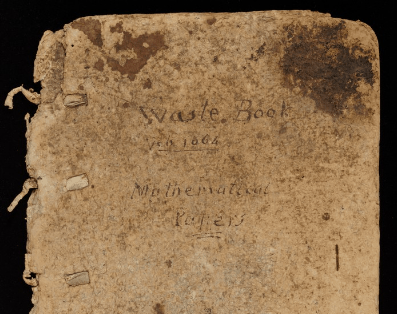
In 1666, Cambridge University closed its doors to help stop the spread of the black plague. This sent a precocious 23 year-old student named Isaac Newton back to Woolshtrope Manor, a family estate located 60 miles northwest of the school. Newton’s main diversion: a thick, largely empty, 1000-page commonplace notebook that he’d inherited from his stepfather.
Newton decided to fill in its pages with his answers to an increasingly difficult series of mathematical questions he devised for himself. In doing so, he invented calculus.
Not bad for a school break.
If you’re interested in learning more about Newton’s miraculous year:
- Check out this history, published recently by Jonathan Kujawa on 3 Quarks Daily (if you don’t know this website, ask any science geek you know to explain it to you). This was the article that inspired this post.
- You can browse Newton’s notebook online via Cambridge’s digital library.
- You can find nice images of Woolsthorpe Manor and its grounds here, and watch a short video about Newton’s work at Woolsthorpe here.

There are some interesting parallels to be drawn to the Feynman’s ‘NOTEBOOK OF THINGS I DON’T KNOW ABOUT’.
Interestingly, this led to a bitter confrontation with Leibniz from Germany, who published his paper on calculus earlier than Newton, while Newton claimed priority of inventing calculus.
I mention this because I once sat in a lecture in which a professor claimed, “Had the plague not visited Cambridge and had Newton not sought refuge to his home, calculus may have never been invented.”
Which is of course false, because it also was invented by Leibniz, unbeknownst to Newton. The dy/dx-Notation goes back to Leibniz, whereas Newton used the dots above the letters.
Of course, this is not to belittle the work of this great genius. But he wasn’t the only genius of his time capable of these insights.
On the other hand, we don’t know what really happened. If Leibniz really built on Newton’s ideas an developed calculus from that, as Newton blamed Leibniz of plagiarism, calculus may have indeed been invented much later, if at all, had Newton died from the plague. Not to speak of his great insights to the description of gravity and his systematization of mechanics.
A fictionalised account of this story is featured in Quicksilver, by Neal Stephenson, whose working practices follow deep work principles alongside intentionalised use of technology.
Back then his distraction was sitting under that damn apple tree. Fast forward to the digital device now consuming all intellectual bandwidth. Why weren’t we paying attention ?!
(Shakes fist at iCloud)
I am sat here in my flat in Cambridge as the University has closed due to COVID-19, and it’s just me and the chapters of my PhD thesis. I feel a similar drive to take this time as an opportunity to master my fields; Newton has always served as an intellectual inspiration for me, and now the similarities too haunting to ignore.
Hey Cal,
Long time diligent reader of your blog and books. I work in research and I was wondering if you could write more about how you decide what to work on and when. For example, I usually have three papers I am working on but I find myself all over the place with them.
Daniel
Cal,
Thanks for the shout out!
Best,
Jon
Great parallel with our current situation. Who cares who was first with calculus? I’m much more interested if someone could explain to me why I had such a hard time with the one semester I took, and what parental flaw I passed to my kids who both where upended by mathematical meanderings.